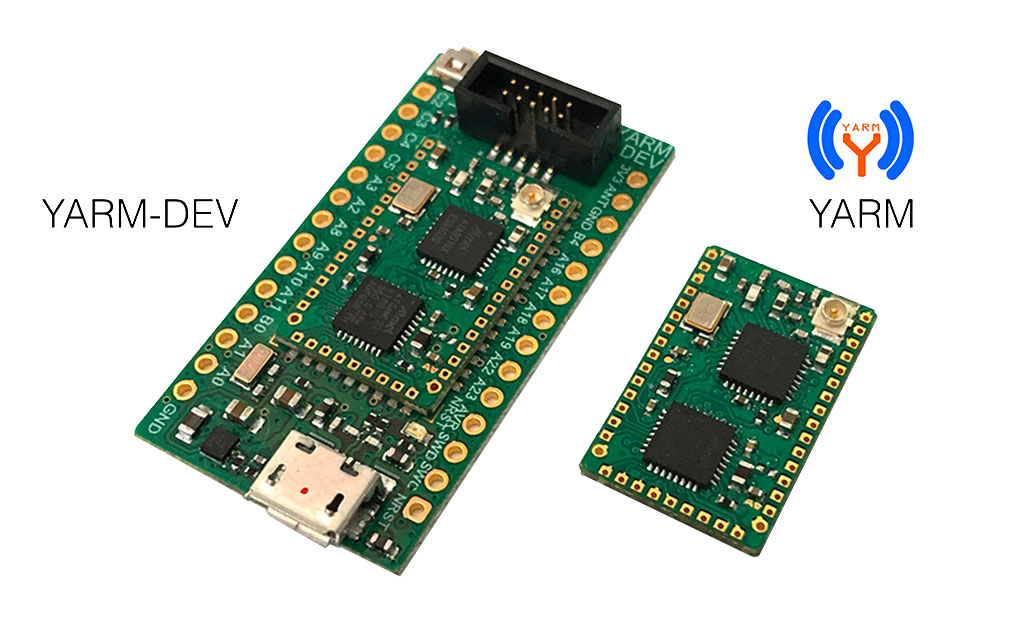mirror of
https://github.com/RIOT-OS/RIOT.git
synced 2025-01-18 12:52:44 +01:00
109 lines
5.6 KiB
Plaintext
109 lines
5.6 KiB
Plaintext
/**
|
|
@defgroup boards_yarm Acmesystems YARM board
|
|
@ingroup boards
|
|
@brief Support for the Acmesystems YARM board.
|
|
|
|
## Overview
|
|
|
|
Yarm is a smart and cost effective solution for system integrators to build
|
|
their own RF applications at 868 MHz avoiding all the hardware design costs
|
|
requested to start a new custom RF project.
|
|
|
|
Yarm integrates:
|
|
|
|
- a Microchip SAML21 low power MCU
|
|
- a Microchip ATA8510 radio module
|
|
|
|
See Acmesystems [product page](https://www.acmesystems.it/yarm) for more
|
|
information.
|
|
|
|
In the provided configuration, stdio is available via USB. The board could be
|
|
configured to provide it on the exposed UART instead, by defining
|
|
|
|
```
|
|
USEMODULE=stdio_uart
|
|
```
|
|
|
|
Depending on the connection to your PC, you will probably also need to set
|
|
PORT_LINUX to a different value (default is /dev/ttyACM0), for instance
|
|
|
|
```
|
|
PORT_LINUX=/dev/ttyUSB0
|
|
```
|
|
|
|
## Hardware
|
|
|
|

|
|
|
|
### MCU
|
|
| MCU | ATSAML21J18B |
|
|
|:------------- |:------------------------------------------------------------------------------------------------------ |
|
|
| Family | ARM Cortex-M0+ |
|
|
| Vendor | Microchip |
|
|
| RAM | 32Kb |
|
|
| Flash | 256Kb |
|
|
| Frequency | up to 48MHz |
|
|
| FPU | no |
|
|
| Timers | 8 (16-bit) |
|
|
| ADCs | 1x 12-bit (20 channels) |
|
|
| UARTs | x 6 (shared with SPI and I2C) |
|
|
| SPIs | max 6 (see UART) |
|
|
| I2Cs | max 6 (see UART) |
|
|
| Vcc | 1.8V - 3.6V |
|
|
| Datasheet | [Datasheet](https://ww1.microchip.com/downloads/en/DeviceDoc/SAM_L21_Family_DataSheet_DS60001477C.pdf) |
|
|
|
|
### RADIO
|
|
| Transceiver | ATA8510 |
|
|
|:------------- |:------------------------------------------------------------------------------------------------------------------- |
|
|
| Vendor | Microchip |
|
|
| Sensitivity | -123dBm |
|
|
| Output power | -12dBm to +14.5dBm programmable in 0.4-dB steps ] |
|
|
| Datasheet | [Datasheet](https://ww1.microchip.com/downloads/en/DeviceDoc/UHF-ASK-FSK-Transceiver-Product-Brief-DS00003077A.pdf) |
|
|
|
|
*NOTE:* not all MCU interfaces are available on YARM; see the
|
|
[pinout](https://www.acmesystems.it/pinout_yarm-dev) to know more.
|
|
|
|
## Implementation Status
|
|
|
|
| Device | ID | Supported | Comments |
|
|
|:---------------- |:----------|:--------- |:------------- |
|
|
| MCU | saml21 | partly | PLL clock not implemented |
|
|
| Low-level driver | GPIO | yes | |
|
|
| | PWM | yes | |
|
|
| | UART | yes | |
|
|
| | I2C | yes | |
|
|
| | SPI | yes | |
|
|
| | USB | yes | |
|
|
| | RTT | yes | |
|
|
| | RTC | yes | |
|
|
| | RNG | yes | |
|
|
| | Timer | yes | |
|
|
| | ADC | yes | |
|
|
|
|
|
|
## Flashing the device
|
|
|
|
Both the MCU and the radio module are flashed using
|
|
[Atmel ICE](https://www.microchip.com/DevelopmentTools/ProductDetails/atatmel-ice),
|
|
with the help of a small adapter. The software used is edbg, bundled with RIOT.
|
|
|
|
[wiring](https://www.acmesystems.it/asquini/yarm_avr_programming/ice-wiring.jpg)
|
|
|
|
On Linux you might have to add a **udev** rule for Atmel ICE, like
|
|
```
|
|
bash
|
|
(
|
|
cat <<END
|
|
# Atmel-ICE JTAG/SWD in-circuit debugger
|
|
ATTRS{idVendor}=="03eb", ATTRS{idProduct}=="2141", MODE="664", GROUP="plugdev"
|
|
END
|
|
) | sudo tee -a /etc/udev/rules.d/99-atmel-ice.rules
|
|
sudo service udev restart
|
|
```
|
|
|
|
## Supported Toolchains
|
|
|
|
Recommended toolchain for SAML21 is [GNU Tools for ARM Embedded Processors](https://launchpad.net/gcc-arm-embedded).
|
|
On Debian Buster, the default [gcc-arm-none-eabi](https://packages.debian.org/buster/gcc-arm-none-eabi)
|
|
package works well.
|